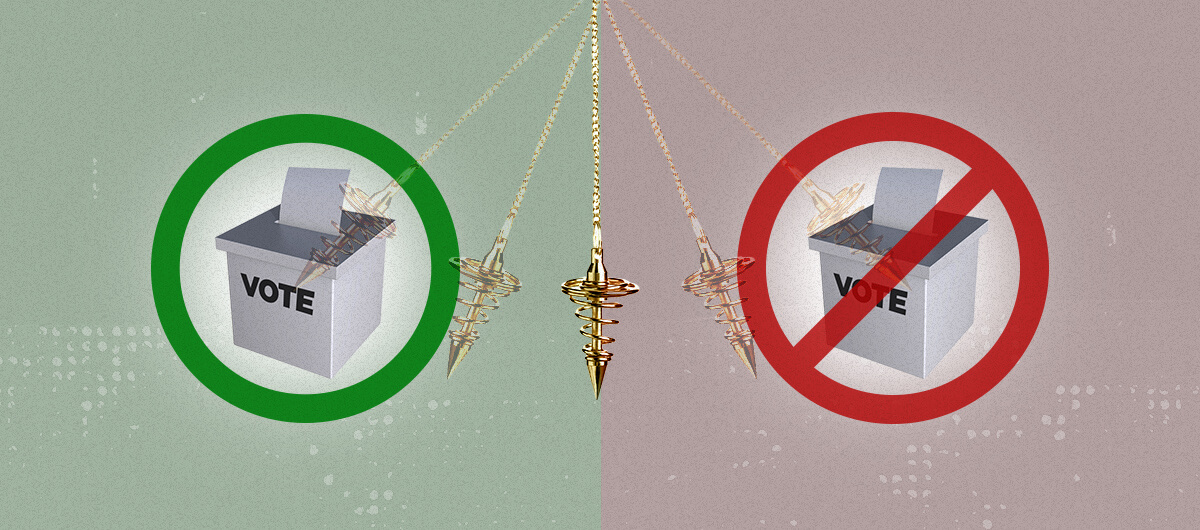

The Fourth Estate
The Real Swing Voters Aren’t Who You Think
The media's obsession with swing voters ignores the disillusioned progressives who could reshape the 2024 election—that is, if they decide to vote at all.
This article was made possible because of the generous support of DAME members. We urgently need your help to keep publishing. Will you contribute just $5 a month to support our journalism?
While the media is busy obsessing over the mythical “swing voters” who supposedly can’t decide between Donald Trump and Kamala Harris, there’s an equally significant—and just as important—group of voters they’re ignoring: left-leaning voters who are just about ready to walk away from the political process altogether. These people aren’t wrestling with a choice between the two major candidates. They’re trying to figure out if they even want to bother participating in a system they feel has screwed them over time and time again.
And this isn’t some minor issue; it’s a quiet but significant shift that could reshape the entire election. The Knight Foundation’s 2020 study found that nearly 100 million eligible Americans didn’t vote in the 2016 presidential election. Many of these non-voters lean progressive on key issues, but they didn’t feel represented by either candidate or believed that their vote wouldn’t make any difference. Unsurprisingly, these non-voters tend to be younger, less wealthy, and come from minority communities—the very groups that traditionally support progressive policies.
One reason for 2024’s disillusionment is foreign policy, particularly when it comes to Gaza and the Israeli-Palestinian conflict. A lot of progressive voters are fed up with what they see as the U.S.’s one-sided stance that ignores the humanitarian crisis in Gaza. For these voters, the Biden-Harris administration’s handling of the issue has been a huge letdown, leaving them in a moral bind: Do they vote for a candidate whose foreign policy they disagree with, or stay home, knowing that by sitting out, they could end up helping someone take power who is far more destructive?
And it’s not just foreign policy turning them off. Climate change, healthcare, income inequality—these are issues where the Democratic Party keeps making promises but then, well, doesn’t really follow through. A recent Pew Research Center survey showed that a decent number of Democratic voters want the party to embrace more progressive policies, especially when it comes to healthcare. But when those bold changes fail to materialize, it’s no surprise that enthusiasm plummets.
We saw how this played out in 2016. Only about 60% of eligible voters showed up—meaning nearly 40% stayed home. Young voters in particular didn’t bother showing up to the polls. In key swing states like Michigan, Wisconsin, and Pennsylvania, Trump won by razor-thin margins—sometimes less than 1%. Meanwhile, third-party candidates pulled in just enough votes to possibly tip the scales. It’s not a stretch to say that if more disillusioned progressives had shown up, things could have turned out very differently.
The media, of course, plays a big role in this mess. By ignoring these voters and their concerns, mainstream outlets send a clear message: Your issues aren’t important enough to cover. A study by Harvard’s Shorenstein Center found that 2020 election coverage was mostly horse-race nonsense, with barely any attention given to the policies that actually impact people’s lives. When the media treats elections like a reality-TV show, it just reinforces the idea that politics is disconnected from real life.
Focusing so much on supposed “swing voters” torn between Trump and Harris creates a false equivalence, like the only people up for grabs are somewhere in the middle. In reality, the electorate is way more polarized. This oversimplified narrative misses the complexity of who’s actually out there. Democracy depends on people participating—not just the “holding-your-nose-and-voting-for-the-least-awful-option” kind of participation. When huge chunks of the population are so disillusioned they stop engaging, the entire system weakens. Policies become less representative, and the cycle of apathy just deepens.
Re-engaging these voters isn’t going to happen through vague promises. Both the media and politicians need to address what’s really driving their frustration. That means real, honest discussions about foreign policy, bold action on climate change, meaningful healthcare reform, and a genuine commitment to tackling inequality. If the media shifted its focus to these issues—and the voters who care about them—they could actually make a difference. Highlighting the real-world impact of policies, giving a platform to disenfranchised voices, and holding politicians accountable could help revive democratic participation.
In the end, the real “swing voters” are the millions of Americans wondering if their vote even matters in a system that appears to disregard their concerns. Addressing them isn’t just good journalism—it’s essential for the future of democracy.
Before you go, we hope you’ll consider supporting DAME’s journalism.
Today, just tiny number of corporations and billionaire owners are in control the news we watch and read. That influence shapes our culture and our understanding of the world. But at DAME, we serve as a counterbalance by doing things differently. We’re reader funded, which means our only agenda is to serve our readers. No both sides, no false equivalencies, no billionaire interests. Just our mission to publish the information and reporting that help you navigate the most complex issues we face.
But to keep publishing, stay independent and paywall free for all, we urgently need more support. During our Spring Membership drive, we hope you’ll join the community helping to build a more equitable media landscape with a monthly membership of just $5.00 per month or one-time gift in any amount.



















































































